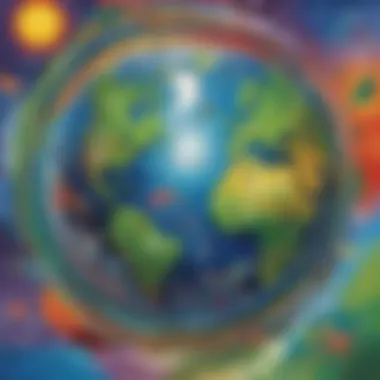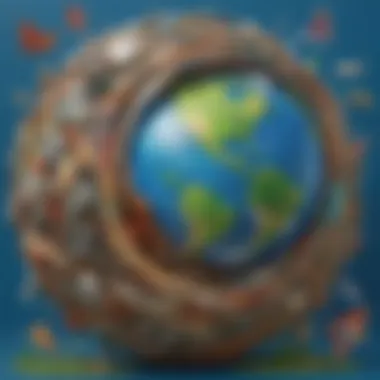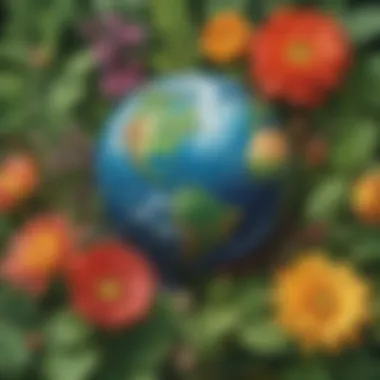Engaging Earth Day Art Projects for Young Learners: Inspire Creativity!


Creative Activities
Earth Day is a special time to explore our connection to the environment through creative activities. For elementary school children, engaging in hands-on art projects can be both fun and educational. One exciting way to commemorate Earth Day is through creative craft ideas that promote sustainability. These craft projects provide children with the opportunity to learn about recycling and upcycling materials around them. From making planters out of old containers to creating artworks from scrap paper, the possibilities are endless.
Craft Ideas
Craft ideas for Earth Day can encompass a wide range of eco-friendly projects. Children can create bird feeders from recycled milk cartons, turning everyday items into something beneficial for the environment. Another engaging idea is designing nature collages using leaves, petals, and sticks found in the backyard. This not only encourages creativity but also instills a sense of appreciation for the natural world.
Step-by-Step Guides
Providing step-by-step instructions for each activity is essential to ensure children can easily replicate the projects. Clear and concise guidance helps in creating a structured approach to the art projects. Including visuals or videos along with the instructions can further aid in the comprehension of each step. By breaking down the tasks into manageable steps, children can feel a sense of accomplishment as they progress through the activities.
Educational Value
Engaging in Earth Day art projects offers numerous educational benefits for elementary school children. Through these creative endeavors, children can learn about the importance of conservation, sustainability, and environmental awareness in a hands-on manner. By incorporating elements of science, art, and sustainability, these activities not only stimulate creativity but also promote critical thinking and problem-solving skills.
Introduction to Earth Day Art Projects
Earth Day serves as a crucial moment for instilling environmental consciousness in young minds. Through art projects, elementary school children can explore the significance of this global event in a tangible and creative way. By engaging in various artistic endeavors, kids not only develop their artistic skills but also gain a deeper understanding of the importance of environmental sustainability. The Introduction to Earth Day Art Projects section sets the stage for children to delve into eco-friendly creativity that not only educates but also inspires.
Significance of Earth Day for Kids
The Significance of Earth Day for Kids lies in its ability to empower the future generation with knowledge about environmental conservation. Children are introduced to the concept of Earth Day and its relevance in promoting green practices. It serves as a platform for youngsters to discover the impact of their actions on the planet, encouraging them to adopt eco-friendly habits early on. Understanding the Significance of Earth Day nurtures a sense of responsibility and stewardship towards the environment.


Benefits of Engaging in Art Projects
Engaging in Art Projects offers a myriad of benefits for elementary school children. Through hands-on art activities, kids can unleash their creativity while learning about environmental themes. Art projects foster critical thinking, problem-solving, and fine motor skills in children. Furthermore, by working on eco-conscious art projects, kids develop a sense of appreciation for nature and sustainable living practices. The Benefits of Engaging in Art Projects extend beyond artistic expression, nurturing well-rounded individuals with a deep respect for the environment.
Recycled Art Projects
Recycled art projects hold a unique significance in the realm of Earth Day activities for elementary school children. Emphasizing sustainability and creative reuse, these projects aim to instill eco-consciousness and innovation in young learners. By employing materials that would otherwise end up in landfills, students not only engage in artistic expression but also learn the value of upcycling and reducing waste. The exploration of recycled art projects within this article underscores the importance of environmental stewardship and inspires children to view discarded items with a new lens of possibility.
Creating Art from Recycled Materials
Cardboard Tube Binoculars
Cardboard tube binoculars stand out as a captivating avenue for incorporating recycled elements into art projects. These binoculars, crafted from common household materials such as toilet paper rolls, exemplify resourcefulness and creativity. One key aspect of cardboard tube binoculars lies in their simplicity, making them accessible and engaging for young creators. Their lightweight design and ease of assembly make them a popular choice for Earth Day activities, offering children a hands-on experience in crafting functional items from reused materials. While cardboard tube binoculars may lack the durability of store-bought versions, their eco-friendly nature and low-cost appeal align perfectly with the ethos of recycled art projects.
Plastic Bottle Planters
Plastic bottle planters emerge as a practical and environmentally conscious addition to Earth Day art endeavors. Transforming discarded plastic bottles into vessels for plant life showcases the dual purpose of recycling and gardening. A key characteristic of plastic bottle planters lies in their adaptability and versatility. These planters provide an ideal canvas for children to learn about sustainable practices in both art and horticulture. The unique feature of plastic bottle planters lies in their transparency, allowing young artists to witness the growth of plants from seed to sprout. While plastic bottle planters promote sustainability, their potential drawbacks may include occasional leaking or brittleness, factors that educators can address through reinforcement and waterproofing techniques.
Newspaper Collage Art
Newspaper collage art cultivates a sense of texture and history within the realm of recycled art projects. By repurposing newspapers into vibrant collages, children can explore themes of composition and contrast while utilizing sustainable materials. A defining characteristic of newspaper collage art is its versatility, offering endless possibilities for creative expression. The crinkling of newsprint, combined with colorful imagery, adds depth and visual interest to artistic compositions. The advantage of newspaper collage art lies in its accessibility and affordability, making it an inclusive choice for classrooms and homes alike. Potential challenges may arise from the fragility of newsprint when exposed to moisture, requiring careful handling and preservation techniques.
Importance of Recycling in Art


Exploring the importance of recycling in art unveils a holistic approach to environmental education through creative expression. By integrating recycled materials into artistic endeavors, students not only learn about sustainability but also witness firsthand the transformative power of repurposing. Recycling in art fosters critical thinking skills, encouraging children to consider the lifecycle of materials and the impact of their artistic choices. This awareness extends beyond Earth Day projects, instilling a sense of responsibility and environmental consciousness in young learners. By emphasizing the significance of recycling in art, educators can empower students to become stewards of the environment while nurturing their artistic abilities.
Nature-Inspired Art Projects
In this segment, we delve into the significance of incorporating nature-inspired art projects within Earth Day activities for elementary school children. The fusion of art and nature is not just aesthetically pleasing but also serves as a powerful educational tool. By engaging in nature-inspired art projects, children develop a profound connection with the environment while honing their artistic skills. These activities encourage young learners to explore the beauty of nature and express their creativity through different mediums such as leaves, rocks, and seeds.
Exploring Art through Nature
Leaf Printing:
Leaf printing is a fascinating art technique that involves pressing leaves onto paper to create intricate patterns and designs. This activity allows children to connect with nature directly and understand the unique shapes and textures of various leaves. The key characteristic of leaf printing lies in its simplicity yet ability to produce stunning results. It is a popular choice for Earth Day projects as it showcases the beauty of nature while promoting sustainable practices. One advantage of leaf printing is its accessibility, requiring minimal materials yet offering endless creative possibilities for young artists.
Rock Painting:
Rock painting involves decorating rocks with different colors and designs, transforming them into miniature works of art. This activity enables children to explore their artistic abilities while appreciating the natural aesthetic of rocks. The key characteristic of rock painting is its versatility, allowing kids to experiment with various painting techniques and patterns. Rock painting is a beneficial choice for Earth Day art projects as it instills a sense of appreciation for the environment and encourages recycling by using natural canvases. One unique feature of rock painting is its durability, making it a long-lasting form of artistic expression.
Seed Mosaic Art:
Seed mosaic art involves creating intricate designs using a variety of seeds, showcasing a blend of creativity and sustainability. This activity allows children to work with natural materials to craft unique artworks while learning about different seed types. The key characteristic of seed mosaic art is its eco-friendly nature, utilizing organic elements to compose beautiful patterns. It is a popular choice for Earth Day projects as it emphasizes the importance of agriculture and environmental preservation. One advantage of seed mosaic art is its educational value, teaching kids about seed diversity and ecological harmony.
Connecting with the Environment Through Art
This section emphasizes the profound impact of connecting with the environment through art, highlighting how these nature-inspired activities cultivate a sense of environmental consciousness in children. By immersing themselves in creative projects that celebrate nature, kids develop a deeper appreciation for the world around them and become motivated to protect and preserve it. Engaging in art that reflects nature fosters a holistic understanding of environmental issues and encourages youngsters to become stewards of the planet for future generations.


Collaborative Art Projects
In the realm of Earth Day art projects for elementary school children, Collaborative Art Projects hold a pivotal role. These projects are more than just artistic endeavors; they serve as platforms for young minds to collaborate, communicate, and create together. By working on such projects, kids learn the essence of teamwork, empathy, and shared achievement. Collaborative Art Projects also instill a sense of collective responsibility towards a common goal, highlighting the interconnectedness present in the process of creating art as a group.
Fostering Teamwork through Art
Classroom Mural Creation
The Classroom Mural Creation aspect of Collaborative Art Projects symbolizes unity and harmony within a classroom setting. It involves students coming together to contribute individual artistic expressions, ultimately culminating in a collective masterpiece. The key characteristic of Classroom Mural Creation lies in its ability to unify diverse ideas and styles into a cohesive visual narrative. This approach fosters inclusivity, as every student's contribution is valued and integrated into the final mural. The unique feature of Classroom Mural Creation is its power to enhance collaboration skills while celebrating diversity, making it a popular choice in Earth Day art activities for elementary school children.
Group Eco-Collage
Group Eco-Collage focuses on creating artistic compositions using recycled materials, emphasizing environmental consciousness. This aspect of Collaborative Art Projects encourages students to explore sustainability through creative expression. The key characteristic of Group Eco-Collage is its promotion of eco-friendly practices and resourcefulness. By utilizing materials that would otherwise be discarded, students learn the significance of recycling and repurposing in art. The unique feature of Group Eco-Collage lies in its ability to raise awareness about environmental issues while nurturing teamwork and creativity. Incorporating Group Eco-Collage in Earth Day art projects instills a sense of responsibility towards nature and community, shaping young individuals into environmentally conscious citizens.
Promoting Community and Environmental Awareness
The underlying purpose of Promoting Community and Environmental Awareness in Collaborative Art Projects is to extend the impact of children's creativity beyond the classroom. These projects serve as avenues for students to share their artistic endeavors with the community, fostering a sense of interconnectedness and environmental stewardship. By showcasing their artwork, children not only celebrate their achievements but also raise awareness about pressing environmental concerns. This aspect emphasizes the role of art in initiating conversations and inspiring action within local communities. Through collaborative art projects, students become ambassadors of change, promoting community engagement and environmental awareness through their creative expressions.
Interactive Art Exhibitions
In the realm of Earth Day art projects for elementary school children, Interactive Art Exhibitions stand out as a pinnacle of creativity and engagement. These exhibitions provide a platform for students to not only showcase their artistic talents but also to communicate powerful messages about environmental conservation. By allowing children to actively participate in creating art pieces that convey their thoughts on pressing environmental issues, Interactive Art Exhibitions serve as a dynamic medium for learning and self-expression. This hands-on approach fosters a deeper connection with nature and instills a sense of responsibility towards protecting the planet. Moreover, these exhibitions encourage collaboration and critical thinking, as students work together to curate displays that resonate with viewers of all ages. Through Interactive Art Exhibitions, young learners can explore complex ecological concepts in a visually captivating and accessible manner.
Showcasing Student Artwork
One of the fundamental aspects of Interactive Art Exhibitions is the showcasing of student artwork. This segment is not merely about displaying creative pieces; it is a celebration of the students' exploration of environmental themes through art. Each artwork tells a unique story, reflecting the individual perspectives and insights of the young artists. By showcasing student artwork in exhibitions, educators and parents can witness the growth and development of each child's environmental consciousness and artistic skills. Moreover, this display serves as a powerful motivator for students, validating their efforts and encouraging them to continue exploring the intersection of art and sustainability. The process of selecting, organizing, and presenting student artwork fosters a sense of pride and achievement among young learners, establishing a strong link between creativity, education, and environmental awareness.
Educational Impact of Art Display
The Educational Impact of Art Display within Interactive Art Exhibitions transcends traditional classroom learning. By engaging in the curation and presentation of artworks focused on ecological themes, students are exposed to a multi-faceted educational experience. This exposure goes beyond theoretical knowledge, allowing children to delve into practical applications of environmental concepts. Through the act of displaying their art to a wider audience, students gain confidence in their abilities and learn the art of effective communication. Furthermore, the process of explaining their artwork's underlying environmental messages enhances critical thinking and articulation skills. As viewers interact with these art displays, they are not only inspired by the creativity on show but also educated about the importance of environmental stewardship. The Educational Impact of Art Display solidifies the link between art, education, and environmental advocacy, creating a lasting impression on both the creators and the audience.







